 |
|
|
| (Additional information from Jewish War & Jewish Antiquities, Flavius Josephus, and from External Links: University College London, and Encyclopaedia Britannica.) |
|
|
| c.1200 BC |
The Hittite empire collapses, and one of the neo-Hittite states which forms in its place is Tabal. Possibly some elements of the new society are descended from the Sea Peoples. At around the same time, elements from Tabal migrate northwards into the area that becomes known as Paphlagonia. |
|
| 837 BC |
The Assyrian king, Shalmaneser III, records that he receives gifts from the twenty-four kings of Tabal. |
|
| c.780 BC |
List A ( shown below in normal emboldened text) and List B show different kings for the same period, suggesting that they rule simultaneously but in different parts of the state. 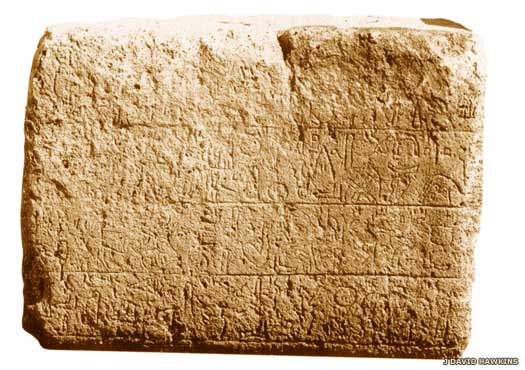 Shown here are original Luwian inscriptions from one of two blocks which were found at Çalapverdi in modern Turkey Shown here are original Luwian inscriptions from one of two blocks which were found at Çalapverdi in modern Turkey |
|
| early 700s BC |
Tuwatis |
|
| fl c.770s BC |
Tuate |
|
| 743 - 740 BC |
The Assyrians under Tiglath-Pileser III besiege[Bit Agusi](SyriaArpad.htm#Bit Agusi) for three years, thanks to the city being an ally of Urartu. Once captured, the city is destroyed and its inhabitants are massacred. It is probably around this period that the Urartuans also lose their domination of the northern part of[ Syria](SyriaCityStates.htm#Greater Syrian States). Their defeat also opens up Anatolia to the Assyrians, and Tabal is almost instantly attacked. Tabal is still divided into several independent principalities, but all of them are sizeable enough to merit the use of the title 'king' for their rulers even though Assyrian vocabulary has now extended beyond using it for every ruler they meet. While 'Tabal' is used in conjunction with the capital of a specific kingdom within the region, it is also used to encompass all of the people of that region who share the same cultural traditions and leave similar Luwian inscriptions. |
|
| 743 - 738 BC |
Tabal is employed as a blanket designation in an Assyrian administrative note written at some point between 743 and 738 BC, which lists the tribute payments of nine kings of Tabal (SAA 11 30). Three of those kings can be identified with rulers who are known from Assyrian inscriptions or local monuments written in the Luwian language and script. |
|
| fl 740 BC |
Ašhittu / Ušhittu / Askwisis of Atuna |
A king of Tabal (one of many). Remained in 738 & 732 BC. |
| fl 740 BC |
Tuatti / Tuwatis of Bit-Purutaš / Tabal |
Bit-Purutaš may equal Burutash, mentioned elsewhere. |
| Finds of Luwian inscriptions suggest the region of Kayseri as the location of Bit-Purutaš / Tabal. The site of Kululu, where monuments of a number of kings of Tabal have been found, is the most likely to correspond to Tabal's capital. |
|
|
| fl 740 BC |
Hanubuni |
|
| fl 740 BC |
Kalu |
|
| fl 740 BC |
Pulî |
|
| fl 740 BC |
Uluanda |
|
| fl 740 BC |
Hili |
Same as Hidi, below? Remained in 730s. |
| c.738 - 713? BC |
Wasusurmas of Tabal / Uassurme |
Son of Tuwatis of of Bit-Purutaš. |
| Wasusurmas fails to pay the tribute owed to Sargon of Assyria and as a result he and his royal clan are removed from power in Bit-Purutaš. In his place, Hulli, the 'son of a nobody' replaces him. |
|
|
| 732 BC |
? of Ištunda |
The king's name is not recorded, although the city is. |
| 732 BC |
? of Hubišna |
The king's name is not recorded, although the city is. |
| fl 730s - 720s BC |
Warpalawas of Tuhana / Urbala'a |
Remained active into the reign of Sargon II of Assyria. |
| fl c.720s? BC |
Hulli of Bit-Purutaš |
Son of 'a nobody'. Raised by Sargon of Assyria. |
| Tuhana is the best known of the Tabalean principalities. Its capital of the same name can be safely identified with the[ Hellenistic](../KingListsEurope/GreeceMacedonia.htm#Great Kings),Roman and Byzantine city of Tyana whose ruins lie in the modern Turkish village of Kemerhisar, to the south of Niğde, where a stele of King Warpalawas is uncovered in 1860. |
|
|
| 715 BC |
Despite sharing culinary and aesthetic tastes, Assyria andPhrygia are on bad terms. Although there are no relevant sources prior to Sargon's reign, his own inscriptions describe Midas of Phrygia as having long been a thorn in the empire's side, having never submitted to Sargon's predecessors and refusing diplomatic contacts. Now, Sargon's army conquers some fortresses in westernQue that Midas of Phrygia had taken 'very long ago', indicating that Midas must have been in power for some time. This campaign results in an Assyrian foray deep into Phrygia but does not stop Midas from his continuing intervention in Que and Tabal. |
|
| ? - c.713 BC |
Ambaris of Bit-Purutaš |
Son of Hulli of Bit-Purutaš. |
| Ambaris continues his father's role as a protégé of Sargon of Assyria. At his accession, Sargon gives his own daughter in marriage and as her dowry he doubles the size of Bit-Purutaš. |
|
|
| 714 - 713 BC |
Much to Sargon's shock, while the main Assyrian army is occupied in the east, probably in [Elamite](EasternElam.htm#Late Elam) lands, Ambaris allies himself with Midas of Phrygia and Rusa of Urartu as well as the local Tabalean rulers in an attempt to invade Que. Sargon reacts quickly, invading Tabal and capturing Ambaris, his family and the nobles of his country, all of whom are taken to Assyria. Tabal is annexed as an Assyrian province. Sargon is noted for using Cimmerians within his army on this campaign, possibly for their knowledge of the Urartuan hills as much as their ability as mounted warriors. Cimmerians have been raiding into Mesopotamia for decades. 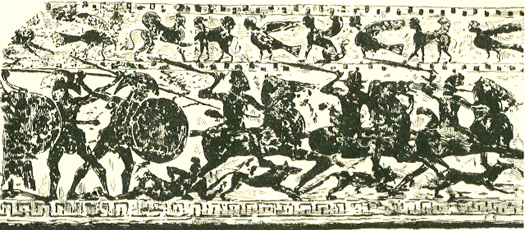 This image shows Cimmerians battling early Greeks - prior to the advent of accepted 'Classical' Greece - with the mounted Cimmerians warriors apparently being accompanied by their dogs This image shows Cimmerians battling early Greeks - prior to the advent of accepted 'Classical' Greece - with the mounted Cimmerians warriors apparently being accompanied by their dogs |
|
| 711 BC |
The creation of the province of Tabal has only further escalated the situation and Assyria now finds itself at war with assorted Tabalean principalities andPhrygia, and moreover increasingly on the losing side. Despite huge investments in the protection of the new border, including the fortification of Til-Garimmu (modern Gürün) and the construction of the so-called Cappadocian Wall, the province of Tabal is now lost, never to be retaken. |
|
| 705 BC |
Sargon of Assyria dies on the battlefield while attempting to reconquer Tabal. Not only does the attempt fail but Sargon's body cannot be recovered for burial. |
|
| fl c.690 BC |
Hidi |
|
| fl c. 670 BC |
Mugallu |
|
| 652 BC |
One serious invasion of Anatolia by Cimmerians has already been repulsed, with the states or regions of Hilakku, [Lydia](AnatoliaLydia.htm#Mermnad Lydia), and Tabal requesting help from Assyria. Now the Cimmerians return (leader unknown). King Gyges of Lydia is killed during a second attack. His capital of Sardis is captured, all except the citadel which manages to hold out. The fact that it does suggests either that either the Cimmerians do not hang around for long after their victory or that (as before) they are moved along by an Assyrian force. Excavations at the site of Sardis later discover a destruction layer that appears to be associated with this event. |
|
| fl c.650 BC |
x-ussi |
An incomplete name. |
| 641 - 640 BC |
After more than a decade of controlling a vast domain, Tugdamme of the Cimmerians is now defeated. Unfortunately the details of how this happens have failed to survive, so the manner of his defeat and death are unknown. Either way, this would appear to be the point at which the Cimmerians largely break up as a cohesive force. Elements settle in Tabal and Thrace, and may well also contribute greatly to the last great thrust of horse-borne warrior groups migrating westwards along the Danube to influence the Celts (even if this is only in terms of cultural and military influences upon Indo-European elements which are already migrating in that direction). Scythian culture takes over in the Caucasus and Pontic steppe, so it is clear that whatever Cimmerians remain there are no longer at all dominant or powerful. |
|
| 609 - 546 BC |
Documentation of Tabal fades as the Assyrian empire fades, which is to be expected as the empire has largely been the only source of written information about Tabal. Now, Babylonia under the leadership of Necho takes control of the region while the crown prince, Nebuchadnezzar, leads the Babylonian forces in [Syria](SyriaCityStates.htm#Greater Syrian States) as he inflicts a serious defeat on the[Egyptians](../KingListsAfrica/EgyptAncient%5FLatePeriod.htm#26th Dynasty) at Carchemish in 605 BC. |
|
| 549 - 546 BC |
The Persian defeat of the Medes opens the floodgates for Cyrus with a wave of conquests, beginning with Cilicia in 549 BC. Harpagus, a Median of the royal house and the main cause of the defeat of the Medes, commands Cyrus' army in Anatolia, conquering it between 547-546 BC. Taken during this campaign are Caria, Lycia, [Lydia](AnatoliaLydia.htm#Mermnad Lydia), Paphlagonia, Phrygia, and Tabal (Cappadocia), and Harpagus and his descendants reign thereafter in Karkâ (Caria) and Lykia (Lycia) as satraps of the empire, normally within the satrapy of Karkâ. |
|
|
|
|
| Persian Satraps of Katpatuka (Cappadocia) Conquered by Cyrus the Great, the region of Tabal was added to the Persian empire. Under the Persians, it was formed into an official satrapy or province, and the satraps ruled the region in the name of the Persian king. Unfortunately, there is no information about the structure of the administrative hierarchy here until the time of Datames in the mid-fourth century BC. He began his career as satrap of Cappadocia-beside-the-Pontus (Katpatuka) and was promoted to take over the minor satrapy of Cappadocia-beside-the-Taurus (Khilakku). The River Halys separated these two very minor provinces. Following the Persian invasion of Anatolia between 549-546 BC, the new great satrapy of Sparda initially controlled not only the territory of the former kingdom of [Lydia](AnatoliaLydia.htm#Mermnad Lydia), but also Katpatuka (Tabal) which had been the initial target of Lydia's aggression, the reason that Lydia had been conquered in the first place. More specifically, the great satrapy of Sparda consisted of the central minor satrapy of Lydia around its capital of Sardis, and the more peripheral minor satrapies of Hellespontine Phrygia, Greater Phrygia, Karkâ, and Skudra between 512-479 BC. The former kingdom and now-region of Mysia was rarely important enough to warrant many further mentions in history, but subsequent references to it are handled under the satraps of Sparda. Katpatuka was presumably governed by a local dynasty at the start of the Persian period (at least, Diodorus seems to think so). The central minor satrapy of Katpatuka, otherwise known as Cappadocia-beside-the-Pontus, had western and southern borders that were formed by the bend of the Halys, within which lived the Cappadocian natives, the Leucosyrians (Leukosurioi or Surioi). The Halys not only separated Cappadocia-beside-the-Pontus from Cappadocia-beside-the-Taurus, but also from Greater Phrygia and Paphlagonia. The eastern border touched the sea immediately to the west of Cotyora. The course of the frontier with (West) Armenia cannot be determined precisely. The name Katpatuka is of uncertain origin, first appearing in records after the Persian conquest of the region (notably the Behistun inscription of Darius the Great). Some modern writers ascribe 'Cappadocia' to the Cimmerians who are thought to have settled here after their great defeat around 641-640 BC. If the Cimmerians referred to their homeland (either the original one or this potential new one) as Cimmeria then Katpatuka is certainly not derived from it. However, Katpatuka certainly does supply the Greek form of the name, Cappadocia. Katpatuka softens the two 't' letters so that one vanishes and the other becomes a 'd' in Cappadocia. And one may safely assume that both of the 'c' letters in Cappadocia are pronounced as a 'k', but then what if the 'kat-' of Katpatuka means 'battle'...? That would mean an Indo-European word origin which has the same meaning as the Celtic word for battle, 'cat'. Could the Cimmerians have been responsible for that...? |
|
|
 |
|
|
| (Information by Peter Kessler, with additional information by Edward Dawson, from The Persian Empire, J M Cook (1983), from The Histories, Herodotus (Penguin, 1996), from Ctesias' Persica in its Near Eastern Context, Matt Waters, from Beiträge zur Geschichte und Sage von Iran, J Markwart (Marquart) (ZDMG 49, 1895, in German), and from External Links: Encyclopaedia Iranica, and Lives of Eminent Commanders, Cornelius Nepos (1886 Edition).) |
|
|
| 547 - 546 BC |
The defeat of the Medes opens the floodgates for Cyrus the Great with a wave of conquests, beginning with Cilicia in 549 BC. Harpagus, a Median of the royal house and the main cause of the Median defeat, commands Cyrus' army in Anatolia, conquering it between 547-546 BC. Taken during this campaign are Armenia, Caria, Lycia, [Lydia](AnatoliaLydia.htm#Mermnad Lydia), Paphlagonia, Phrygia, and Tabal (Cappadocia), and Harpagus and his descendants reign thereafter in Karkâ and Lykia (Lycia) (and apparently Cilicia too) as satraps. 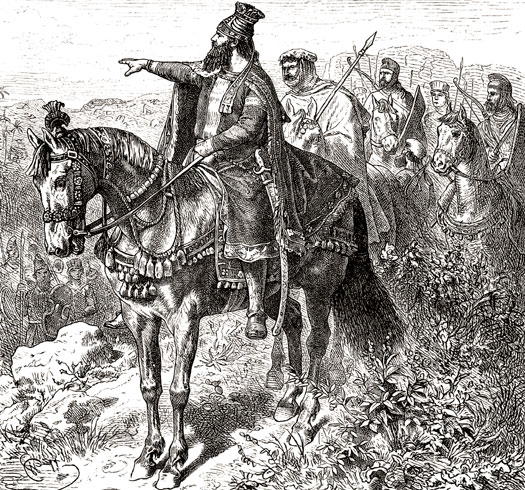 Cyrus the Great freed the Indo-Iranian Parsua people from Median domination to establish a nation which is recognisable to this day, and an empire which provided the basis for the vast territories which were later ruled by Alexander the Great Cyrus the Great freed the Indo-Iranian Parsua people from Median domination to establish a nation which is recognisable to this day, and an empire which provided the basis for the vast territories which were later ruled by Alexander the Great |
|
| Renamed as the minor region of Katpatuka, Tabal is apparently governed by Atrabates. The name is coincidentally the same as the Atrebates tribe of Britons, and has an apparent meaning that would be inappropriate for an individual. Could he instead be Atradates, also seemingly known as Mitradates, foster-father of Cyrus? |
|
|
| fl c.540s? BC |
Atrabates |
Satrap of Katpatuka? Not verified. |
| fl c.520s? BC |
Ariaramnes |
Satrap of Katpatuka? Not verified. |
| 513 BC |
Ariaramnes is claimed by the unreliable Ctesias as satrap of Katpatuka while Herodotus, who is very reliable on Anatolia, does not mention him. The claim is that Darius orders Ariaramnes to cross the Black Sea to conduct a preliminary reconnaissance of the Scythian territories there. Ariaramnes brings back prisoners which include the brother of the Scythian king, and the resultant protests give Darius his excuse to go to war in Scythia. It is possible that Ariaramnes is instead based in Hellespontine Phrygia, as Katpatuka may not even be a satrapy at this time. |
|
| fl 510s BC |
Ariamnes |
First confirmed satrap. |
| The name Ariamnes looks very much like Aryaman, the Hindu deity, with a nominative suffix added on. It's hard to be sure what the Luwian suffix may be, but using a Greek/Celtic suffix the name would read Ariamanos. Using the proto- Indo-European suffix it would be Ariamanaz. |
|
|
| fl 480 BC |
Gobryas |
Half-brother of Xerxes of Persia. |
| 480 BC |
 Neighbouring Paphlagonia with its still-independent princes contributes an important contingent to the Persian army of Xerxes which invades Greece. The Persians subdue the Thracian tribes and the Macedonians. Then the vast army of Xerxes makes its way southwards and is swiftly engaged by [ Athens](../KingListsEurope/GreeceAthensGreeks.htm#Elected Archons Classical) and Sparta in the Vale of Tempe. The Persians are subsequently stymied by a mixed force of Greeks - which includes Athenians, Corinthians, Helots, Mycenaeans, Thebans, and Thespians - led by Sparta under King Leonidas at Thermopylae. (These events are depicted somewhat colourfully - but no less impressively for that - in the 2007 film, 300.) The Persian army is held up long enough for the Athenians to prepare their navy for a seaborne engagement with the Persian fleet. Neighbouring Paphlagonia with its still-independent princes contributes an important contingent to the Persian army of Xerxes which invades Greece. The Persians subdue the Thracian tribes and the Macedonians. Then the vast army of Xerxes makes its way southwards and is swiftly engaged by [ Athens](../KingListsEurope/GreeceAthensGreeks.htm#Elected Archons Classical) and Sparta in the Vale of Tempe. The Persians are subsequently stymied by a mixed force of Greeks - which includes Athenians, Corinthians, Helots, Mycenaeans, Thebans, and Thespians - led by Sparta under King Leonidas at Thermopylae. (These events are depicted somewhat colourfully - but no less impressively for that - in the 2007 film, 300.) The Persian army is held up long enough for the Athenians to prepare their navy for a seaborne engagement with the Persian fleet. 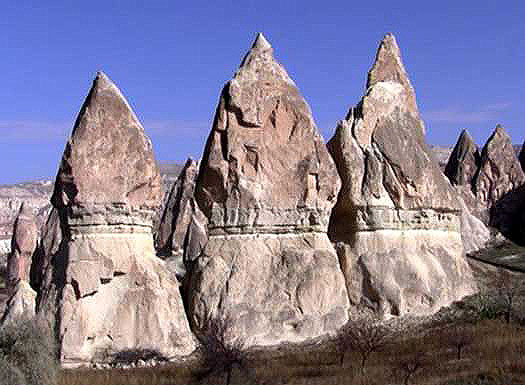 The Persian satraps of Katpatuka found themselves in a land which was filled with Hittite monuments which predated their arrival by at least half a millennium The Persian satraps of Katpatuka found themselves in a land which was filled with Hittite monuments which predated their arrival by at least half a millennium |
|
| c.480 - 400? BC |
At some point in this period Katpatuka's northern coastal region is divided from the satrapy to form a new province called Pontus. The exact date at which this occurs is unknown, but it is an established fact by the time of Xenophon of [ Athens](../KingListsEurope/GreeceAthensGreeks.htm#Elected Archons Classical) in the first half of the fourth century BC. |
|
| c.375 BC |
Mithridates of Chios |
Possibly related to Ariobarzanus of Phrygia. |
| c.375 - 362 BC |
Datames |
Son of Camissares, satrap of Khilakku & Paphlagonia. Killed. |
| 367 BC |
Ariobarzanus, satrap of Phrygia, joins Datames, satrap of Khilakku and Katpatuka and independent ruler of Paphlagonia, in revolt against Artaxerxes II. Autophradates, satrap of Sparda, is ordered to suppress the rebellion and he manages to expel Ariobarzanes from the greater part of his satrapy. In 365 BC, [ Athens](../KingListsEurope/GreeceAthensGreeks.htm#Elected Archons Classical) sends thirty ships and 8,000 mercenaries to aid Ariobarzanus. He rewards Athens with the gift of Sestos and Crithote, cities on the Thracian Chersonesus. |
|
| fl 364 BC |
Aspis |
Satrap of Cataonia. Subjugated. |
| 364 BC |
This seems to be the point at which the native princes of Paphlagonia are finally removed from holding any kind of office. They are replaced by various individuals from more powerful regions. By now the Greek city of Sinope has also fallen under Persian domination. Datames is the first outsider to take control there. Given the fact that he is in revolt against Persia, it would seem that Paphlagonia has been seized as part of this effort. He also subjugates the minor satrap of Cataonia - a division of Katpatuka itself - the otherwise unknown Aspis. Soon all of Asia Minor (Anatolia) revolts against Artaxerxes II and, in 362 BC, even Autophradates is driven to join the rebels. Sparta, and also Takhôs, pharaoh of [ Egypt](../KingListsAfrica/EgyptAncient%5FLatePeriod.htm#30th Dynasty), send substantial help to the rebels. Two years later, in 360 BC, Ariobarzanes is betrayed by his son, Mithridates, and is executed. The satrapal revolt is finally suppressed in 359-358 BC, by which time Datames' son, Ariaramnes, is satrap of Katpatuka. |
|
| 362 - 350 BC |
Ariaramnes I / Ariamnes |
Son. Great uncle of Cyrus the Great of Persia. |
| 350 - 334 BC |
Ariarathes I |
Son of Ariaramnes. Became satrap for GreekCappadocia. |
| ? - 334 BC |
Mithrobouzanes |
Persian satrap of Katpatuka during the reign of Darius III. |
| 334 - 333 BC |
In 334 BC Alexander of [ Macedon](../KingListsEurope/GreeceMacedonia.htm#Great Kings) launches his campaign into the Persian empire by crossing the Dardanelles. The first battle is fought on the River Graneikos (Granicus), eighty kilometres (fifty miles) to the east. Dismayed at the Persian defeat, Satrap Arsites of Daskyleion commits suicide. Sparda surrenders, but Karkâ's new satrap holds out in the fortress of Halicarnassus with the Persian General Memnon. 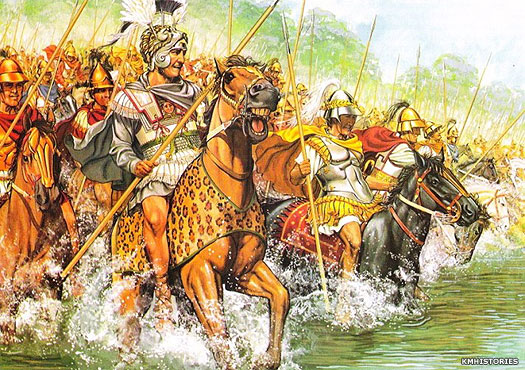 Alexander the Great crossed the River Graneikos (or Granicus) in 334 BC to spark a direct face-off with the Persians which had been brewing for generations, and his victory in battle near the river sent shockwaves through the Persian empire Alexander the Great crossed the River Graneikos (or Granicus) in 334 BC to spark a direct face-off with the Persians which had been brewing for generations, and his victory in battle near the river sent shockwaves through the Persian empire |
|
| Mithrobouzanes, perhaps only commanding briefly in Katpatuka, is killed at Graneikos and Ariarathes is the one to benefit, becoming governor of northern Cappadocia (Katpatuka) under Alexander. It has been put forward (by Marquart at least) that Mithrobouzanes could be a son of Ariarathes, which would certainly help to explain how the latter could be accounted as governing Katpatuka at the same time as him. Cappadocia is also easily divided into north and south regions (as demonstrated under [ Greek](../KingListsEurope/GreeceMacedonia.htm#Great Kings) rule), and Mithrobouzanes may command the south only, with Ariarathes in the north. |
|
|
|
|
|
| Argead Dynasty in Cappadocia The Argead were the ruling family and founders of Macedonia who reached their greatest extent under Alexander the Great and his two successors before the kingdom broke up into several Hellenic sections. Following Alexander's conquest of the Persian holdings in Anatolia and Syria between 334-331 BC, the [ Greek](../KingListsEurope/GreeceMacedonia.htm#Great Kings) empire ruled the region until Alexander's death in 323 BC and the subsequent regency period which ended in 310 BC. Alexander's successors held no real power, being mere figureheads for the generals who really held control of Alexander's empire. Following that latter period and during the course of several wars, Anatolia was divided between Cassander of Macedonia, the Lysimachian empire, and the Antigonid. empire As Katpatuka, the region of Cappadocia had been a Persian satrapy for some time (since 547-546 BC). Alexander the Great swept away Persian power in Anatolia during his conquests of 334-331 BC, and initially he attempted to impose his own commander in Cappadocia whilst being entirely occupied with conquering Egypt and Babylonia. In these early days of establishing his [ Greek](../KingListsEurope/GreeceMacedonia.htm#Great Kings) empire he was less successful in that attempt than he would later be. Cappadocia's former satrap, Ariarathes, declared himself king in 331 BC and his satrapy of Cappadocia became the kingdom of Cappadocia. |
|
|
 |
|
|
| (Information by Peter Kessler, with additional information from The Augustan Empire, 43 BC-AD 69, A K Bowman, E Champlin, & A Lintott (1996), from The Persian Empire, J M Cook (1983), from The Histories, Herodotus (Penguin, 1996), from Dictionary of Greek and Roman Biography and Mythology, William Smith (Ed, Little, Brown & Company, 1849), and from External Links: Encyclopaedia Britannica, and Appian's History of Rome: The Syrian Wars at Livius.org, and Pera: Ancient Pergamum, and Encyclopaedia Iranica, and Lives of Eminent Commanders, Cornelius Nepos (1886 Edition).) |
|
|
| 333 - 323 BC |
Alexander III the Great |
King of [ Macedonia](../KingListsEurope/GreeceMacedonia.htm#Great Kings). Conquered Persia. |
| 323 - 317 BC |
Philip III Arrhidaeus |
Feeble-minded half-brother of Alexander the Great. |
| 317 - 310 BC |
Alexander IV of Macedonia |
Infant son of Alexander the Great and Roxana. |
| 334 - 333 BC |
In 334 BC Alexander of [ Macedon](../KingListsEurope/GreeceMacedonia.htm#Great Kings) launches his campaign into the Persian empire by crossing the Dardanelles. The first battle is fought on the River Graneikos (Granicus), eighty kilometres (fifty miles) to the east. The Persian defeat forces Satrap Arsites of Daskyleion to commit suicide. Sparda surrenders but Karkâ's satrap holds out in the fortress of Halicarnassus with the Persian General Memnon. The fortress is blockaded and Alexander moves on to fight the Lykian mountain folk during the winter when they cannot take refuge in those mountains. 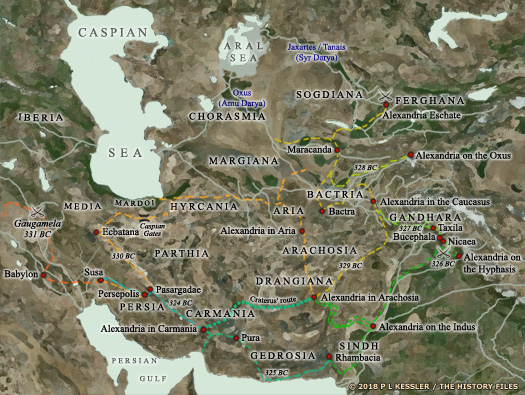 The route of Alexander's ongoing campaigns are shown in this map, with them leading him from Europe to Egypt, into Persia, and across the vastness of eastern Iran as far as the Pamir mountain range (click or tap on map to view full sized) The route of Alexander's ongoing campaigns are shown in this map, with them leading him from Europe to Egypt, into Persia, and across the vastness of eastern Iran as far as the Pamir mountain range (click or tap on map to view full sized) |
|
| The campaigning season of 333 BC sees Darius III and Alexander miss each other on the plain of Cilicia and instead fight the Battle of Issos on the coast. Darius flees when the battle's outcome hangs in the balance, gifting the Greeks Khilakku and Katpatuka (Cappadocia), although pockets of Persian resistance remain in parts of Anatolia. However, Greek control of Katpatuka is fleeting, and Satrap Ariarathes remains in office throughout the period. |
|
|
| 334 - 331 BC |
Ariarathes |
Former satrap of Katpatuka. Declared independent kingdom. |
| 334 - 333 BC |
Abistamenes |
[ Greek](../KingListsEurope/GreeceMacedonia.htm#Great Kings) satrap in southern Cappadocia only. Killed? |
| 334/333 BC |
The hold by Abistamenes over his southern Cappadocian territories seems loose at best. Cappadocians can still be found fighting for Darius III at the subsequent Battle of Gaugamela in 331 BC. Abistamenes himself seems to occupy his position only briefly, and already seems to have disappeared by 333 BC, following the Battle of Issus. |
|
| 333 - 332 BC |
Sabiktas |
[ Greek](../KingListsEurope/GreeceMacedonia.htm#Great Kings) satrap in southern Cappadocia only. |
| 332 - 321 BC |
? |
Unknown[ Greek](../KingListsEurope/GreeceMacedonia.htm#Great Kings) satraps in southern Cappadocia only. |
| 331 BC |
Despite the attempts by Alexander the Great's [ Greek](../KingListsEurope/GreeceMacedonia.htm#Great Kings) empire to rule the region through its own military commanders, the long-serving Ariarathes seizes this opportunity to go it alone. He declares his independence as king of Katpatuka, although it is far more recognisably known by the Greek form of its name - Cappadocia. |
|
|
|
|
| Kingdom of Cappadocia (Katpatuka) As Katpatuka, the region that formed the kingdom of Cappadocia had been a Persian satrapy for some time (since 547-546 BC). Alexander the Great swept away Persian power in Anatolia during his conquests of 334-331 BC, and initially he attempted to impose his own commander in Cappadocia (a Greek version of 'Katpatuka'), whilst being entirely occupied with conquering Egypt and Babylonia. In these early days of establishing his [ Greek](../KingListsEurope/GreeceMacedonia.htm#Great Kings) empire he was less successful in that attempt than he would later be. Katpatuka's former satrap, both for the Persians and for Alexander as his satrap of Cappadocia, Ariarathes, declared himself king in 331 BC. During the majority of its existence the kingdom was neighboured to the north by Pontus and Lesser Armenia, to the east by Armenia Sophene, to the south-east by Commagene, to the south by Cilicia, and to the west by Phrygia. Ariarathes himself managed to extend the kingdom's borders to the Black Sea. Initially, Ariarathes held onto his kingdom in northern Cappadocia, subduing the region of Cataonia while Greek satraps governed the south. But there were far more powerful forces at work in the region. Upon the death of Alexander the Great, his generals began fighting amongst themselves for control of his empire. Although Ariarathes only ever held northern Cappadocia, even that was lost after his murder in 322 BC, by which time he was aged eighty-two. For a time the kingdom was a plaything of the Wars of the Diadochi. However, Cappadocia did re-emerge as an independent kingdom in the third century BC. |
|
|
 |
|
|
| (Information by Peter Kessler, with additional information from The Augustan Empire, 43 BC-AD 69, A K Bowman, E Champlin, & A Lintott (1996), from The Persian Empire, J M Cook (1983), from The Histories, Herodotus (Penguin, 1996), from The Generalship of Alexander the Great, J F C Fuller, from the Historical Dictionary of Ancient Greek Warfare, J Woronoff & I Spence, and from External Links: Encyclopaedia Britannica, and Appian's History of Rome: The Syrian Wars at Livius.org, and Pera: Ancient Pergamum.) |
|
|
| 331 - 323 BC |
Ariarathes I Philádelphos |
Former satrap of Greek Cappadocia. Killed 322 BC. |
| 332 - 321 BC |
? |
Unknown[ Greek](../KingListsEurope/GreeceMacedonia.htm#Great Kings) satraps in southern Cappadocia only. |
| 323 BC |
The death of Alexander the Great ends the period of peace in Cappadocia. Ariarathes' kingdom falls to the satraps as Alexander's generals fight for control of his empire. He is captured and executed by Perdiccas, while Eumenes of Cardia is the first to seize control of the whole kingdom, but he faces opposition in the form of Nikanor. |
|
| 323 - 319 BC |
Eumenes of Cardia |
[ Greek](../KingListsEurope/GreeceMacedonia.htm#Great Kings) general. Ruled all of Cappadocia, but not uncontested. |
| 322 BC |
Alexander's former secretary, Eumenes, is confirmed as ruler of Cappadocia by the [ Greek](../KingListsEurope/GreeceMacedonia.htm#Great Kings) regent, Perdiccas. The regent underlines his choice of ruler by defeating the deposed Ariarathes, and then having him and many of his relations crucified. Eumenes soon finds his rule opposed by Nikanor, a Macedonian officer who serves first Cassander, would-be regent and king of Greece, and then Antigonus. 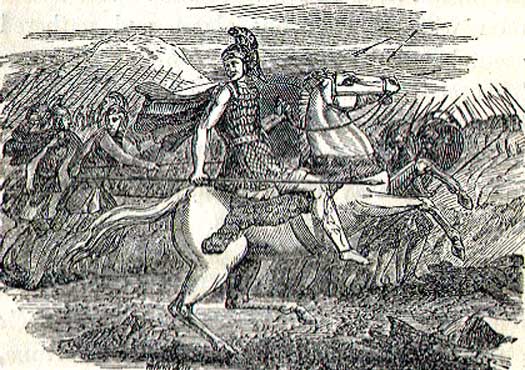 Eumenes of Cardia, Macedonian general and one of Alexander the Great's 'successors' between whom a series of wars were fought Eumenes of Cardia, Macedonian general and one of Alexander the Great's 'successors' between whom a series of wars were fought |
|
| 322 - 316 BC |
Nikanor / Nicanor |
Opponent of Eumenes. Transferred toMedia by Antigonus. |
| 319/306 - 301 BC |
The death of Antipater of [ Greece](../KingListsEurope/GreeceMacedonia.htm#Great Kings) leads to the Second War of the Diadochi. He had passed over his son, Cassander, in favour of Polyperchon as his successor (possibly to avoid claims of dynasticism) but the two rivals go to war. In the resultant shifts in power and control, Cappadocia and its surrounding regions (including Paphlagonia) become part of the Antigonid empire and Eumenes is killed. The kingdom of Cappadocia is subsumed within the Antigonid holdings until 301 BC with Nikanor as its satrap until 316 BC. Then he is transferred to govern Media (and seemingly also Parthia from 317 BC, possibly on a temporary basis at first which would explain his nominal continuance in office in Cappadocia until the following year). |
|
| 302 BC |
Once in the service of Antigonus, Mithradates takes control of Pontus from the fragmenting[ Greek](../KingListsEurope/GreeceMacedonia.htm#Great Kings) empire and creates his own kingdom. This also encompasses part ofPaphlagonia and removes Cappadocian access to the Black Sea. It seems that, upon the death of Antigonus at the Battle of Ipsus in the following year, 301 BC, Amyntas attempts to seize control of the Cappadocian region. |
|
| 301 BC |
Amyntas |
Briefly ruled the region. Died. |
| 301 BC |
Amyntas is killed when Ariarathes II of Cappadocia and Ardoates ofArmenia invade. Ariarathes recovers his uncle's throne and restores the native dynasty, but he is forced to accept theSeleucid empire as his overlord. |
|
| 301 - c.280 BC |
Ariarathes II |
Nephew & adopted son of Ariarathes I. Vassal of theSeleucids. |
| c.280 - c.250 BC |
Ariaramnes II |
Son. Vassal of the Seleucids until c.260 BC. |
| 273 BC |
The Galatian Celts invade Greece again, destroying the[ Thracian](../KingListsEurope/GreeceThrace.htm#Odrysian Restored) kingdom and forcing the aristocracy to escape to the Greek colonies bordering the Black Sea, Pontus included. The kingdom of Galatia is created in Anatolia by the victorious Celts. |
|
| c.260 BC |
Cappadocia appears to gain independence from the Seleucid empire. This probably occurs after the death of Antiochus I Soter in 261 BC and while the empire is occupied with Second Syrian War against Ptolemy of Egypt. However, this doesn't prevent Ariarathes III from marrying the daughter of the ruling Seleucid, Antiochus II Theos. 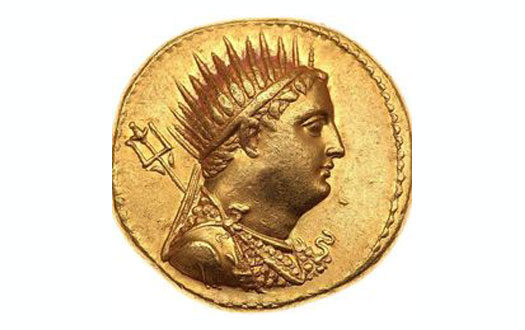 Ptolemy Euergetes increased Egyptian imperial borders at the expense of Seleucid Syria, something which few of his successors were ever able to manage, which also allowed Cappadocia some extra freedoms Ptolemy Euergetes increased Egyptian imperial borders at the expense of Seleucid Syria, something which few of his successors were ever able to manage, which also allowed Cappadocia some extra freedoms |
|
| c.250 - 220 BC |
Ariarathes III |
Son. Co-ruler during his father's lifetime. |
| 220 - 163 BC |
Ariarathes IV Eusebes |
Son. Child at accession. m dau of Seleucid Antiochus III. |
| 216 - 213 BC |
Now strong enough to face his rebellious cousin, Antiochus III of theSeleucid empire is able to march his forces into western Anatolia. By 214 BC Achaeus has been driven back to Sardis where he is captured and executed. The citadel itself is able to hold out until 213 BC under Achaeus' widow Laodice. Central Anatolia has been recovered but several regional dynasties persist in Bithynia, Cappadocia, and Pergamon. Rather than try his hand against these, Antiochus concentrates on the northern and eastern provinces of the empire. Xerxes ofArmenia is persuaded to acknowledge his supremacy in 212 BC, while in 209 BC Antiochus invades Parthia. Its capital, Hecatompylos, is occupied and Antiochus forces his way into Hyrcania, with the result that the Parthian king, Arsaces II, is forced to sue for peace. |
|
| 190 - 188 BC |
Rome defeats the Seleucids in the Seleucid War, taking Asia Minor as a province in 188 BC. The Seleucid ally, Cappadocia, negotiates friendly terms with Rome, notably because Stratonice, the king's daughter, is about to marry the king of Pergamon, a Roman ally. |
|
| 183 - 180 BC |
Further expansion of the kingdom of Pergamon takes place when the [ Thracians](../KingListsEurope/GreeceThrace.htm#Odrysian Restored) are occupied with support from Cappadocia. However, this tough mountainous terrain is too difficult to hold, and within three years, Macedonian supremacy there has been restored. |
|
| 163 - 130 BC |
Ariarathes V Eusebes Philopator |
Son. Killed in battle. |
| 162? - 158 BC |
At the insistence of Rome, Ariarathes V refuses a marriage with Laodice V, sister of Seleucid ruler Demetrius I Soter. Demetrius goes to war and produces Orophernes as a rival claimant to the Cappadocian throne. Ariarathes is temporarily forced to flee to Rome in 158 BC but is quickly restored, although Orophernes is allowed to reign jointly. This arrangement is brief, however, as Ariarathes is soon recorded as being the sole ruler. |
|
| 163 - 157 BC |
Holophernes / Orophernes |
Brother? Rival, sponsored by the Seleucids. Later joint ruler. |
| 131 - 130 BC |
The first Roman army to be sent against Eumenes ofPergamon is joined by their allies from Cappadocia. The attempt meets with failure when the combined armies are defeated. Both Proconsul Publius Licinius Crassus Dives Mucianus and Ariarathes V are killed. 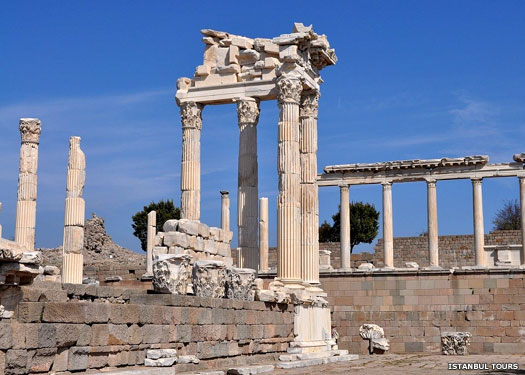 Pergamon rose to prominence during the years of division in the Greek empire following the death of Alexander the Great in 323 BC when his empire was divided among his generals - now it worked in tandem with Cappadocia Pergamon rose to prominence during the years of division in the Greek empire following the death of Alexander the Great in 323 BC when his empire was divided among his generals - now it worked in tandem with Cappadocia |
|
| 130 - 116 BC |
Ariarathes VI Epiphanes Philopator |
Son of Ariarathes V. A child upon succession. Murdered. |
| 130 - 126 BC |
Nysa |
Mother and regent. Killed by nobles for murdering rivals. |
| c.121 - 88 BC |
Once he puts an end to the scheming of his mother (between 116-113 BC), Mithradates VI of Pontus proves to be a resourceful and powerful regional authority. Over the course of the first thirty years of his reign, he methodically captures and adds neighbouring kingdoms and territories to his own realm, including Crimea,Paphlagonia, and (areas of) Cappadocia, and makes Armenia an ally. Though opposed by the Romans in theory, little is done due mainly to Roman wars in Africa (Jugurtha), continuing social disorder, and the crisis of the Germanic (Cimbri and Teutones) invasions. |
|
| 116 BC |
Ariarathes VI is murdered by Gordius on the orders of Mithradates VI Eupator of Pontus. The kingdom is ruled briefly by the former king's widow (probably as regent for her son), and then seized by Bithynia. Mithradates expels the Bithynian king and places Ariarathes VII on the throne. |
|
| 116 BC |
Laodike / Laodice |
Wife of Ariarathes VI, dau. of Mithradates ofPontus. |
| 116 BC |
Nicomedes III |
King of Bithynia. m Laodike. |
| 116 - 101 BC |
Ariarathes VII Philometor |
Son of Ariarathes VI. Installed and killed byPontus. |
| c.101 - c.96 BC |
Ariarathes VIII Epiphanes |
Brother. |
| c.96 BC |
Mithradates VI of Pontus continues his domination of Cappadocia by replacing the native king with his own son. The situation is only briefly endured by the Cappadocian nobles. |
|
| c.95 BC |
Ariarathes IX Eusebes Philopator |
Son of the king ofPontus. Expelled. |
| c.95 BC |
Gordius |
Regent. Murdered Ariarathes VI. |
| 95 BC |
Following Ariarathes IX being expelled, the kingdom is briefly governed directly by Mithradates of Pontus. Control of Cappadocia is vital both to Pontus and nearby Armenia as it serves as a buffer against Roman encroachment. 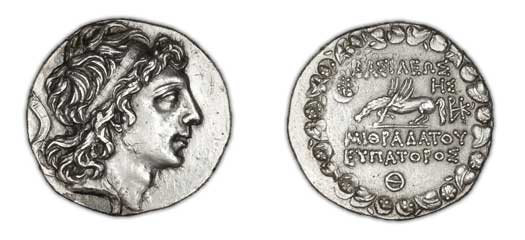 A tetradrachm issued by Mithradates VI of Pontus and Bithynia around 86-85 BC, towards the end of his dominance in Anatolia and the beginning of true Roman dominance A tetradrachm issued by Mithradates VI of Pontus and Bithynia around 86-85 BC, towards the end of his dominance in Anatolia and the beginning of true Roman dominance |
|
| 95 BC |
Ariarathes VIII Epiphanes |
Restored by the nobles and driven out by Mithradates. |
| 95 BC |
Ariarathes IX Eusebes Philopator |
Restored by Pontus. |
| 95 BC |
The eight year-old Ariarathes IX is ordered to be deposed by theRoman Senate, despite claims by Mithradates that he is in fact a descendant of Ariarathes V of Cappadocia. Rome allows the people to select their king, and they chose Ariobarzanes. |
|
| 95 BC |
Ariobarzanes I Philoromanus |
Expelled by Tigranes the Great of Armenia. |
| 95 - 89 BC |
Mithradates of Pontus refuses to be cowed by Roman interference in Anatolia and retakes the kingdom after his ally in Armenia expels Ariobarzanes. Again he places his own son on the Cappadocian throne. |
|
| 95 - 89 BC |
Ariarathes IX Eusebes Philopator |
Restored again byPontus. |
| 89 BC |
On the even of the First Mithridatic War, theRoman Senate restores Ariobarzanes to the Cappadocian throne. This permanently ends Pontic interference in Cappadocian affairs but greatly increases Roman influence to the extent that Cappadocia virtually becomes a Roman client kingdom. |
|
| 89 - 62 BC |
Arionarzanes I Philoromanus |
Restored. Abdicated. |
| 69 - 67 BC |
The imperialistic ambitions of King Tigranes of Armenia lead to war with Rome, and a defeated Armenia becomes tributary to the republic following the campaigns of generals Lucullus (69 BC) and Pompey (67 BC). Seleucid Syria is lost and the Romans distinguish between Greater Armenia and Lesser Armenia, respectively east and west of the Euphrates. The latter is governed by proxy through Rome's client state, Cappadocia. 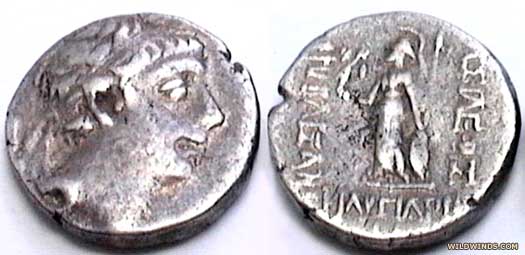 Shown here are both sides of a coin that was issued during the reign of Ariobarzanes II Philopator of Cappadocia Shown here are both sides of a coin that was issued during the reign of Ariobarzanes II Philopator of Cappadocia |
|
| 62 - 51 BC |
Ariobarzanes II Philopator |
Son. Relatively ineffectual. |
| 51 - 42 BC |
Ariobarzanes III Eusebes Philoromanos |
Son. 'Friend of the Romans'. Executed. |
| 49 BC |
Upon Pompey's fall, Pharnaces of Pontus, newly resurgent king of a reduced kingdom that also includes the Cimmerian Bosporus, takes advantage of Julius Caesar being occupied in Egypt, and reduces [ Kolkis](../KingListsEurope/EasternGeorgia.htm#Kingdom of Egrisi), Armenia, and part of Cappadocia, defeating Domitius Calvinus at Nicopolis, whom Caesar subsequently sends against him. Kolkis becomes part of the kingdom of Pontus, along with Lesser Armenia. |
|
| 42 - 36 BC |
Ariarathes X Eusebes Philadelphos |
Brother. Executed. |
| 37 - 36 BC |
Following the execution in 42 BC of Ariobarzanes III by Cassius Longinus, one of the plotters against Julius Caesar, his brother Ariarathes X is removed from power and executed byRoman triumvir Mark Antony. The Cappadocian kingship is now firmly in the hands of Romans. Mark Antony first gifts the throne to Amintas of the Galatians, and then raises the Cappadocian nobleman Sisines to the rank of king in 36 BC, the latter adopting the name Archelaus. Archelaus subsequently deserts Mark Antony at the Battle of Actium in 31 BC. |
|
| 36 BC - AD 17 |
Archelaus (Sisines) |
Roman client. Died in confinement in Rome. |
| 8 BC |
Now a widow of some power and standing, Pythodoria of Pontus marries Archelaus, becoming co-ruler there too. She and her new husband now govern a wide swathe of eastern Anatolia and the South Caucasus. 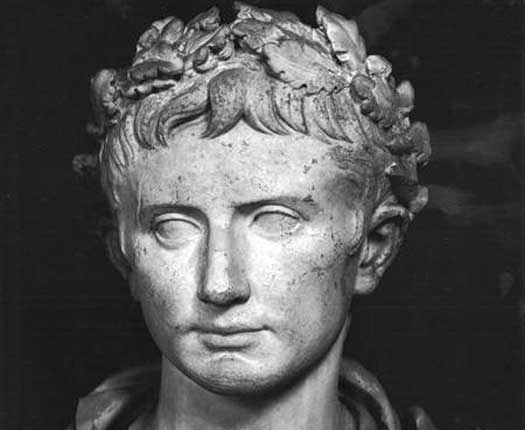 During his long 'reign' as Rome's first citizen, Augustus brought peace to the city and oversaw its transition from failing republic to vigorous and expanding empire During his long 'reign' as Rome's first citizen, Augustus brought peace to the city and oversaw its transition from failing republic to vigorous and expanding empire |
|
| AD 17 |
The aged Archelaus proves relatively popular with Rome but is less liked by the Cappadocians. For angering the Emperor Tiberius after favouring one of his rivals for the imperial diadem, Archelaus is summoned to Rome where he dies, possibly of natural causes (or suicide). Tributary Cappadocia now becomes a Roman province with Pythodoria of Pontus having to return to her own lands, while Armenia and Lesser Armenia are combined and handed to the elder son of Polemon I, Artaxias III, who rules there as a client king. Cilicia is handed to Archelaus' own son to rule as another client king. |
|
 |
|
|

 Shown here are original Luwian inscriptions from one of two blocks which were found at Çalapverdi in modern Turkey
Shown here are original Luwian inscriptions from one of two blocks which were found at Çalapverdi in modern Turkey This image shows Cimmerians battling early Greeks - prior to the advent of accepted 'Classical' Greece - with the mounted Cimmerians warriors apparently being accompanied by their dogs
This image shows Cimmerians battling early Greeks - prior to the advent of accepted 'Classical' Greece - with the mounted Cimmerians warriors apparently being accompanied by their dogs
 Cyrus the Great freed the Indo-Iranian Parsua people from Median domination to establish a nation which is recognisable to this day, and an empire which provided the basis for the vast territories which were later ruled by Alexander the Great
Cyrus the Great freed the Indo-Iranian Parsua people from Median domination to establish a nation which is recognisable to this day, and an empire which provided the basis for the vast territories which were later ruled by Alexander the Great Neighbouring Paphlagonia with its still-independent princes contributes an important contingent to the Persian army of Xerxes which invades Greece. The Persians subdue the Thracian tribes and the Macedonians. Then the vast army of Xerxes makes its way southwards and is swiftly engaged by [ Athens](../KingListsEurope/GreeceAthensGreeks.htm#Elected Archons Classical) and Sparta in the Vale of Tempe. The Persians are subsequently stymied by a mixed force of Greeks - which includes Athenians, Corinthians, Helots, Mycenaeans, Thebans, and Thespians - led by Sparta under King Leonidas at Thermopylae. (These events are depicted somewhat colourfully - but no less impressively for that - in the 2007 film, 300.) The Persian army is held up long enough for the Athenians to prepare their navy for a seaborne engagement with the Persian fleet.
Neighbouring Paphlagonia with its still-independent princes contributes an important contingent to the Persian army of Xerxes which invades Greece. The Persians subdue the Thracian tribes and the Macedonians. Then the vast army of Xerxes makes its way southwards and is swiftly engaged by [ Athens](../KingListsEurope/GreeceAthensGreeks.htm#Elected Archons Classical) and Sparta in the Vale of Tempe. The Persians are subsequently stymied by a mixed force of Greeks - which includes Athenians, Corinthians, Helots, Mycenaeans, Thebans, and Thespians - led by Sparta under King Leonidas at Thermopylae. (These events are depicted somewhat colourfully - but no less impressively for that - in the 2007 film, 300.) The Persian army is held up long enough for the Athenians to prepare their navy for a seaborne engagement with the Persian fleet.  The Persian satraps of Katpatuka found themselves in a land which was filled with Hittite monuments which predated their arrival by at least half a millennium
The Persian satraps of Katpatuka found themselves in a land which was filled with Hittite monuments which predated their arrival by at least half a millennium Alexander the Great crossed the River Graneikos (or Granicus) in 334 BC to spark a direct face-off with the Persians which had been brewing for generations, and his victory in battle near the river sent shockwaves through the Persian empire
Alexander the Great crossed the River Graneikos (or Granicus) in 334 BC to spark a direct face-off with the Persians which had been brewing for generations, and his victory in battle near the river sent shockwaves through the Persian empire
 The route of Alexander's ongoing campaigns are shown in this map, with them leading him from Europe to Egypt, into Persia, and across the vastness of eastern Iran as far as the Pamir mountain range (click or tap on map to view full sized)
The route of Alexander's ongoing campaigns are shown in this map, with them leading him from Europe to Egypt, into Persia, and across the vastness of eastern Iran as far as the Pamir mountain range (click or tap on map to view full sized)
 Eumenes of Cardia, Macedonian general and one of Alexander the Great's 'successors' between whom a series of wars were fought
Eumenes of Cardia, Macedonian general and one of Alexander the Great's 'successors' between whom a series of wars were fought Ptolemy Euergetes increased Egyptian imperial borders at the expense of Seleucid Syria, something which few of his successors were ever able to manage, which also allowed Cappadocia some extra freedoms
Ptolemy Euergetes increased Egyptian imperial borders at the expense of Seleucid Syria, something which few of his successors were ever able to manage, which also allowed Cappadocia some extra freedoms Pergamon rose to prominence during the years of division in the Greek empire following the death of Alexander the Great in 323 BC when his empire was divided among his generals - now it worked in tandem with Cappadocia
Pergamon rose to prominence during the years of division in the Greek empire following the death of Alexander the Great in 323 BC when his empire was divided among his generals - now it worked in tandem with Cappadocia A tetradrachm issued by Mithradates VI of Pontus and Bithynia around 86-85 BC, towards the end of his dominance in Anatolia and the beginning of true Roman dominance
A tetradrachm issued by Mithradates VI of Pontus and Bithynia around 86-85 BC, towards the end of his dominance in Anatolia and the beginning of true Roman dominance Shown here are both sides of a coin that was issued during the reign of Ariobarzanes II Philopator of Cappadocia
Shown here are both sides of a coin that was issued during the reign of Ariobarzanes II Philopator of Cappadocia During his long 'reign' as Rome's first citizen, Augustus brought peace to the city and oversaw its transition from failing republic to vigorous and expanding empire
During his long 'reign' as Rome's first citizen, Augustus brought peace to the city and oversaw its transition from failing republic to vigorous and expanding empire